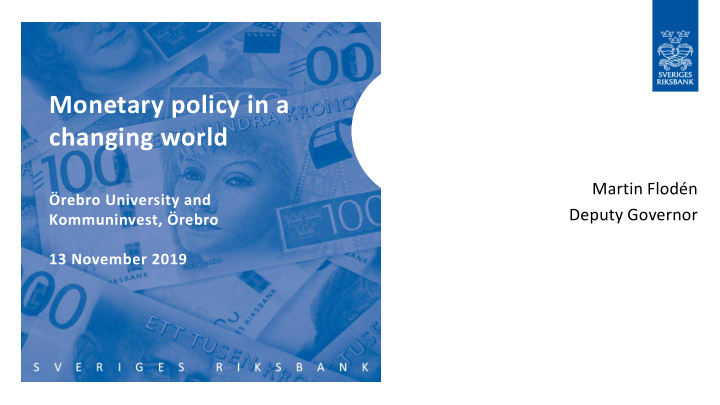



Monetary policy in a changing world Martin Flodén Örebro University and Deputy Governor Kommuninvest, Örebro 13 November 2019
Agenda The economy is changing How large is the monetary policy toolbox? Can the Riksbank contribute towards more sustainable development?
The economy is changing Globalisation has taken a step back China is increasingly important Ageing population, lower population growth Digitalisation Climate change
Globalisation has taken a step back World trade is not growing like before Global value chains are breaking up 80 80 France United states 70 70 Germany Sweden 60 60 50 50 40 40 30 30 90 96 02 08 14 Exports and imports as a proportion of global GDP, per cent, and Sources: World Bank, OECD, IMF, Riksbank and UNCTAD-Eora. proportion of exports linked to global value chains, per cent, respectively.
China is increasingly important China is contributing to higher global saving China: • Share of global GDP increased from 3 to 16 per cent between 1980 and 2018 • Saving ratio increased from 32 to 45 per cent G7 countries: • Saving ratio decreased from 23 to 21 per cent Global saving ratio, per cent of GDP, and contributions from China and Source: IMF WEO. the G7 countries, respectively.
Demography entails lower interest rates and growth Lower population growth • Lower population growth … lower willingness to invest … lower GDP growth • We are living longer … want to save more for our retirements … increased dependency ratio Growth in G7 countries’ population, 25–29 years, annual percentage. Source: UN.
Productivity has grown more slowly Lower productivity growth … lower willingness to invest … lower GDP growth … lower interest rates Growth in OECD countries’ labour productivity, annual percentage. Source: OECD EO.
The economy is changing Lower Willingness to Need to save ↑ productivity invest ↓ growth? Lower Low interest inflationary Low growth rates pressures?
Many indications of continuing low real interest rates 8 8 United Kingdom United States 6 6 Euro Area Sweden 4 4 2 2 0 0 -2 -2 -4 -4 90 95 00 05 10 15 Yield on 10-year real government bonds, per cent, 12 month moving Sources: Bank of England, ECB, Federal Reserve and the Riksbank. average.
How large is the monetary policy toolbox?
The Riksbank’s toolbox Purchase more The interest rate ‘Unconventional’ Swedish can be cut monetary policy government bonds? • But the interest rate is • Term premiums are • Other asset purchases, close to its effective lower already very low helicopter money, … bound • No credit risk for Swedish • Could work but is fiscal government securities policy • The Riksbank already • Sweden’s public finances owns a large share are strong; it is the Government’s task to conduct fiscal policy
Can the Riksbank contribute towards more sustainable development?
Climate change affects the economy The functioning of Can the Riksbank New risks the economy is contribute to better changing sustainability? • Physical risk & transition • Economic relationships • Asset purchases (QE)? risk are changing • Managing the foreign • Adequate supervision and • More noise in the data? exchange reserve? regulation are needed • Primarily Finansinspektionen’s responsibility, but also the Riksbank’s
Can the Riksbank contribute to better sustainability? • Swedish government bonds • The central government is the Riksbank’s principal Asset • Not appropriate for the Riksbank to attempt to affect the purchases Government’s climate work • The Riksbank should not select among government bonds Managing the • The reserve must consist of safe and liquid assets foreign • There is some scope for considering climate change exchange • New risk and investment policy reserve
Greenhouse gas emissions 0.5 0.5 In the foreign exchange reserves 0.4 0.4 Potential holdings 0.3 0.3 0.2 0.2 0.1 0.1 0 0 Direct greenhouse gas emissions, excluding uptake and emission of Sources: UNFCCC, OEDCD, Climate watch. greenhouse gases from land use, GHG (kt CO 2 e)/GDP (mn USD).
The Riksbank rejects issuers with a large climate footprint Holdings Canada and provinces Australia and states Sold 1.4 1.4 1.2 1.2 1.0 1 0.8 0.8 0.6 0.6 0.4 0.4 0.2 0.2 0.0 0 Direct greenhouse gas emissions, excluding uptake and emission of Sources: Australian Bureau of Statistics, Bloomberg, Government of greenhouse gases from land use, GHG (kt CO 2 e)/GDP (mn USD). Australia, Government of Canada, UNFCCC and Statistics Canada.
• What will normal levels be for interest rates and productivity and GDP The economy is changing growth in the period ahead? The Riksbank must understand • Economic correlations are changing, new risks are emerging structural changes • However, monetary policy has little ability to affect these structural changes Fiscal policy is playing a larger • The policy rate is close to its effective lower bound role in stabilisation policy • Fiscal policy can be made more expansionary if necessary The Riksbank shall not conduct • But the Riksbank can take some consideration of climate change in its fiscal or climate policy management of the foreign exchange reserves
Thank you!
Recommend
More recommend